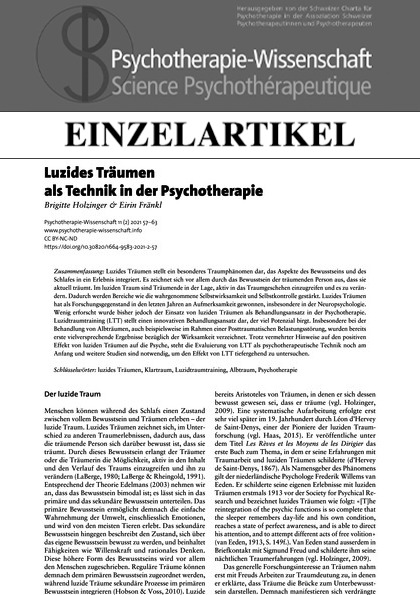Lucid dreaming as a technique in psychotherapy
DOI:
https://doi.org/10.30820/1664-9583-2021-2-57Keywords:
lucid dreaming, lucid dreaming treatment, nightmare, psychotherapyAbstract
Lucid dreaming describes a state between consciousness and sleep. It is characterized above all by the dreamer’s awareness, that he/she is dreaming. In a lucid dream the dreamers have the ability to actively interfere with the dream content and to change its course. Through this technique, psychological skills such as perceived self-efficacy and self-control can be strengthened. Lucid dreaming has gained more attention as a research subject in recent years, particularly in neuropsychology. However, little research has been carried out concerning the use of lucid dreams as a treatment approach in psychotherapy. Lucid Dreaming Treatment (LDT) is an innovative treatment approach that shows great potential. Particularly for the treatment of nightmares, for example in the context of post-traumatic stress disorder, promising results with regard to the effectiveness of LDT have already been recorded. Despite increasing evidence of the positive effect of lucid dreams on the psyche, the evaluation of LDT as a psychotherapeutic technique is still at the beginning and further studies are necessary to examine the effect of LDT in more detail.
Downloads
Published
2021-10-13
How to Cite
Holzinger, B., & Fränkl, E. (2021). Lucid dreaming as a technique in psychotherapy. Psychotherapie-Wissenschaft, 11(2), 57–63. https://doi.org/10.30820/1664-9583-2021-2-57
Issue
Section
Special Issue
License
Copyright (c) 2021 Brigitte Holzinger, Eirin Fränkl

This work is licensed under a Creative Commons Attribution-NonCommercial-NoDerivatives 3.0 Unported License.
This journal provides open access to its content in accordance with the basic premise that the free public availability of research benefits the exchange of knowledge throughout the world.
Authors wishing to publish in this journal agree to the following:
- The author/s retain/s the copyrights and consent/s to initial publication of the work in the journal under a Creative Commons Attribution licence, which allows third parties to use the work by citing the name/s of the author/s and this journal as initial publisher (in accordance with the Creative Commons Attribution-NonCommercial-NoDerivs 3.0 DE-Licence).
- The author/s can enter into additional contracts for the non-exclusive distribution (e.g. publish in a collection or book) of the version published in the journal, if the journal is cited as initial publisher.


